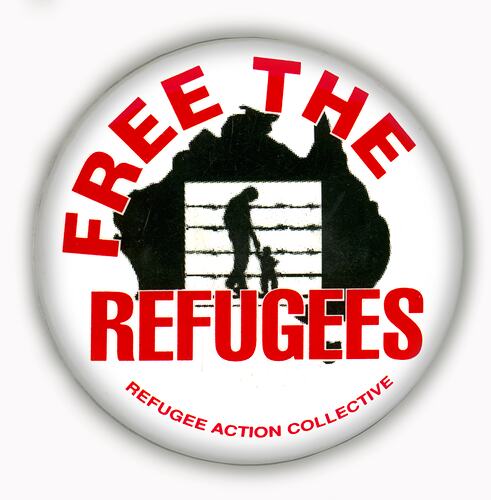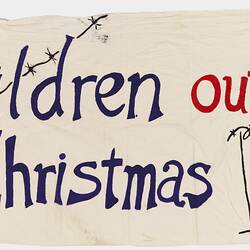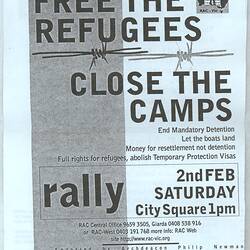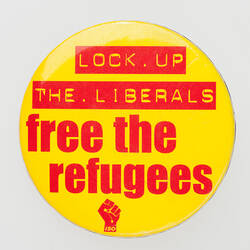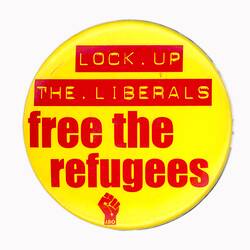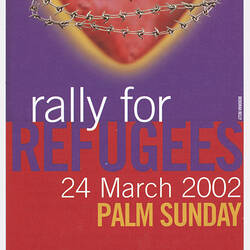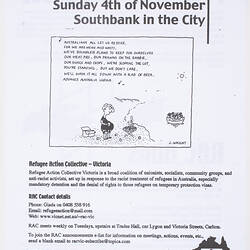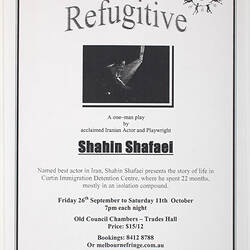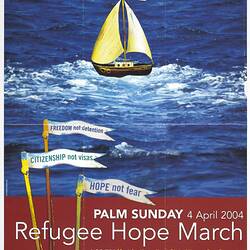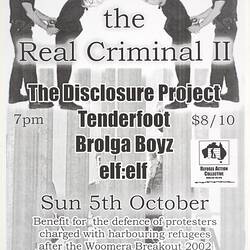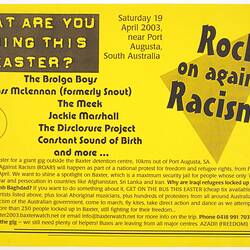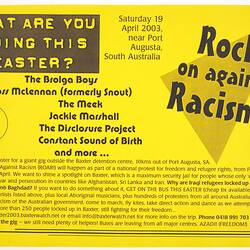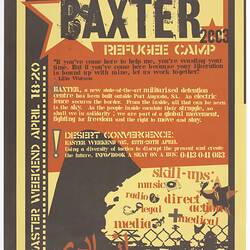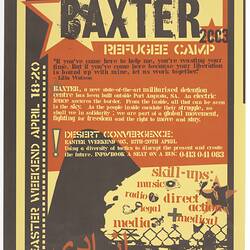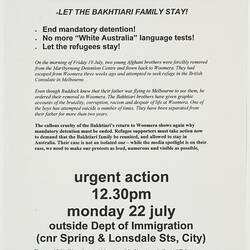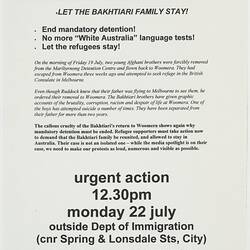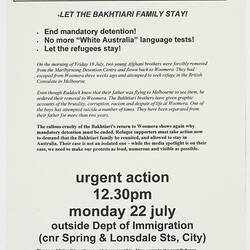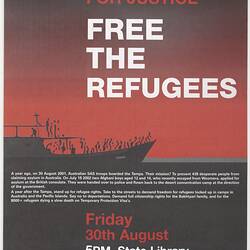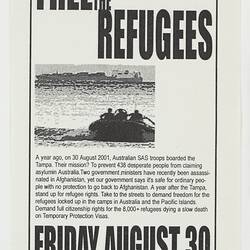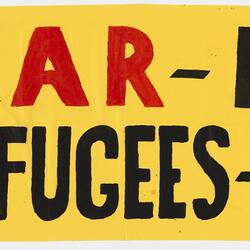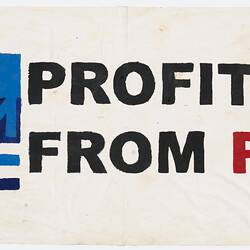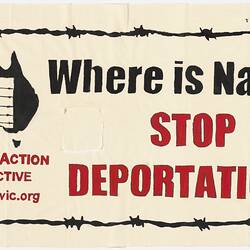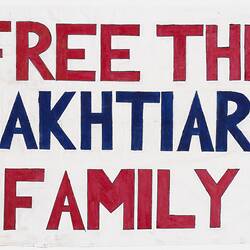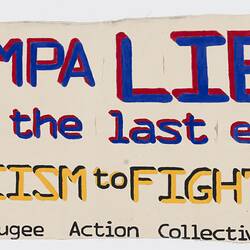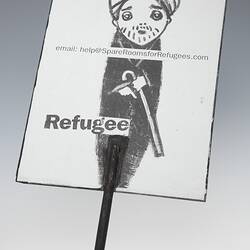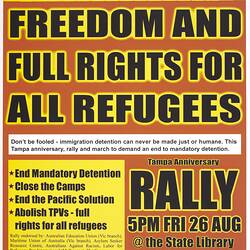Summary
First established in 2000, the Refugee Action Collective grew out of a national grassroots protest movement in response to the treatment of refugees and mandatory detention.
Refugee Action Collective 2000-2004:
The Refugee Action Collective (RAC) grew out of a national grassroots protest movement in response to the treatment of refugees and mandatory detention. First established in 2000, it gained momentum during the Tampa crisis in August 2001. The group has state-based branches, with the Victorian branch meeting weekly on Tuesday nights at Trades Hall, organising protest rallies, sit-ins, and media campaigns as well as participating in sympathetic activities organised by other groups.
The RAC's stated central aim is to change Australian Government policy towards refugees, primarily by ending mandatory detention, closing detention centres, abolishing temporary visas, and allowing those who enter Australian waters by boat to land in Australia. The group has a strong anti-racism message. The RAC has been heavily involved in the campaign for refugee rights in Australia, with branches across the country organising protests, events and actions. It created a standard badge, 'free the refugees' to be used for their campaigns. The badge has been worn to show solidarity with refugees and to promote the cause of those being held in detention centres. The group also distributes posters designed and produced by group members at their homes, while protest banners are designed and painted at Trades Hall and all go through several approval processes by members. The group also distributes the posters of other related organisations which compliment the activities of the RAC.
A solidarity bus trip was organised by the RAC from Melbourne to Woomera on 21 September 2001. According to RAC activist Rachael Evans, 'the bus trip [was] a symbolic action to show that we will not allow the plight of refugees to be hidden in remote locations.' On 24 January 2002 around 500 people attended a rally organised by RAC outside the Department of Immigration and Multicultural Affairs (DIMA) in Melbourne. The rally aimed to protest the government's policy on refugees and to show solidarity with Afghani asylum seekers at Woomera who had gone on hunger strike on 17 January. Mohammed Aljanabi, a former detainee at Woomera spoke of the conditions he had to endure while inside the detention centre for seven months.
Following the rally, police estimated around 100 of the demonstrators entered the Immigration Department offices to further protest. On 2 February 2002 around 4,000 people mobilised in support of asylum seekers in a rally organised by RAC at the then City Square in Melbourne. The rally called for all detention centres to be closed and all those held in detention to be released. Four hundred demonstrators protested outside DIMA again on 12 February, the day of the opening of Parliament in Canberra, to show their anger over Government policies towards asylum seekers.
Jerome Small, one of the original members of the Refugee Action Collective, reflected: 'Late 2001 and early 2002 saw RAC become a very large organisation (100 or more people at each weekly meeting) with working groups organising rallies, publicity material, community outreach and fundraising. RAC's biggest ever demonstration occurred on Palm Sunday 2002, with some 25,000 people marching for refugee rights in Melbourne. A few days later, a protest of over a thousand people (including several busloads organised by RAC) helped to achieve a mass breakout from the Woomera detention centre. Unfortunately, this level of activity could not be sustained. Further rallies involving 2-3,000 in 2002 happened on World Refugee Day and on Tampa Day, as well as a rally of several hundred out at Maribyrnong Detention Centre in Melbourne. Over 2003 and 2004 activity followed much the same pattern, with set piece city rallies on significant dates interspersed with media activity, smaller protests, and educational activities.' The Refugee Action Collective continues to fight for the closure of Australian detention centres, an end to mandatory detention and justice for refugees.
Refugee Action Collective Collection:
Museum Victoria's RAC collection documents the activities of one issue-specific protest group from its early beginning in 2001 to 2004. Material has either been produced by the RAC itself or provides a broader context for the national protest movement in which it was involved. It should be recognised that the RAC is one of many protest groups and initiatives and takes a hard-line approach to its advocacy. Groups have varying opinions and approaches to types and levels of protest; for example, many do not see eye to eye with the RAC on the efficacy of breaking asylum seekers out of Woomera in 2002.
Along with the buttons, postcards and stickers already in the collection, this RAC collection now presents a well-rounded sample of the ephemera of protest - from leaflets, posters and buttons to the actual material culture of the rallies. The items are social documents which portray the slogans and sentiments of one of the most controversial issues relating to Australian immigration policy in recent history. They portray the art and creativity involved in producing posters and banners and the collective processes undertaken in order to get them made. They position Trades Hall (where meetings, decisions and banner creation occurred) and the State Library of Victoria (from where so many of the rallies traditionally depart) as significant geographic focal points for the movement.
Bibliography: Green Left Weekly, 2001-2002. - Refugee Action Collective, 'About RAC', available from http://www.rac-vic.org/about.html, accessed 27 September 2004.
Refugee Action Collective, 'Background Articles: Mandatory Detention', available from http://www.rac-vic.org/back/detent.html, accessed 27 September 2004.
More Information
-
Keywords
Asylum Seekers, Detention Centres, Political Protests, Refugees
-
Authors
-
Article types
